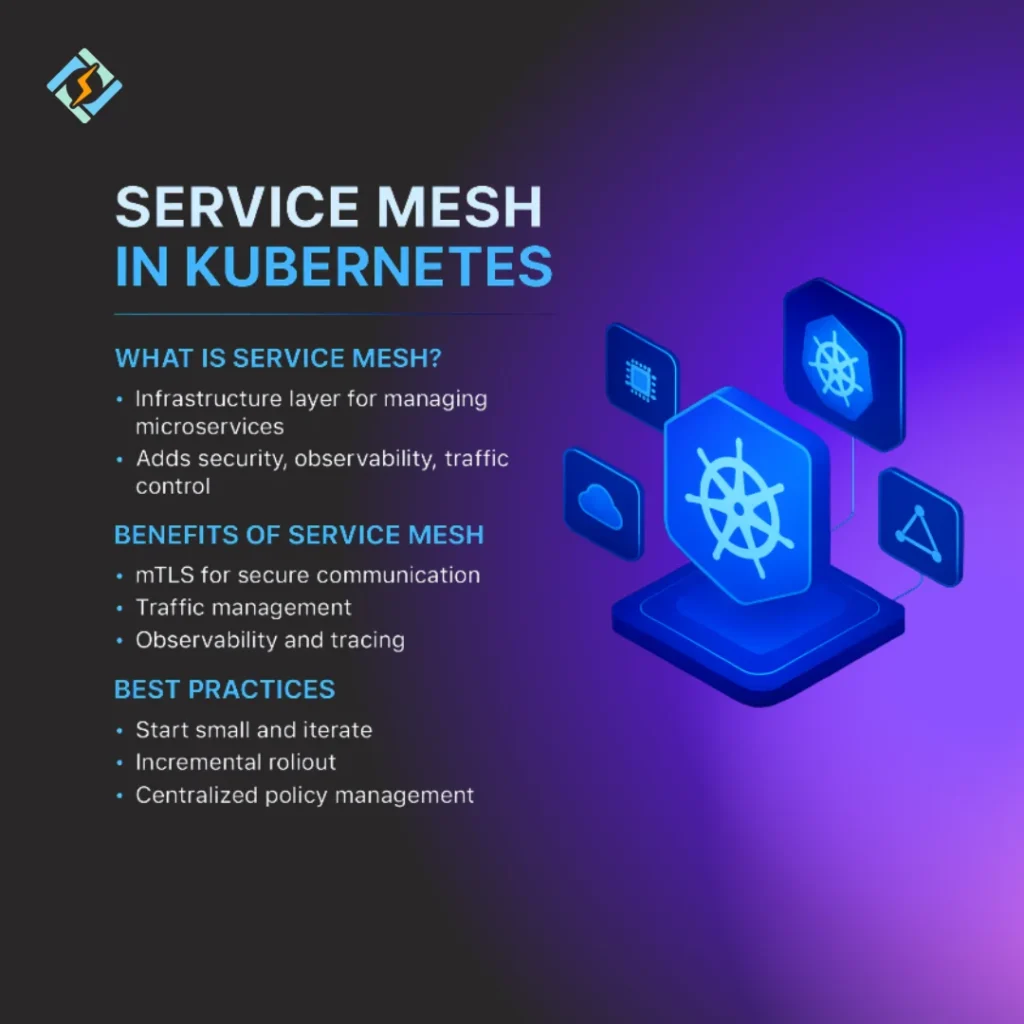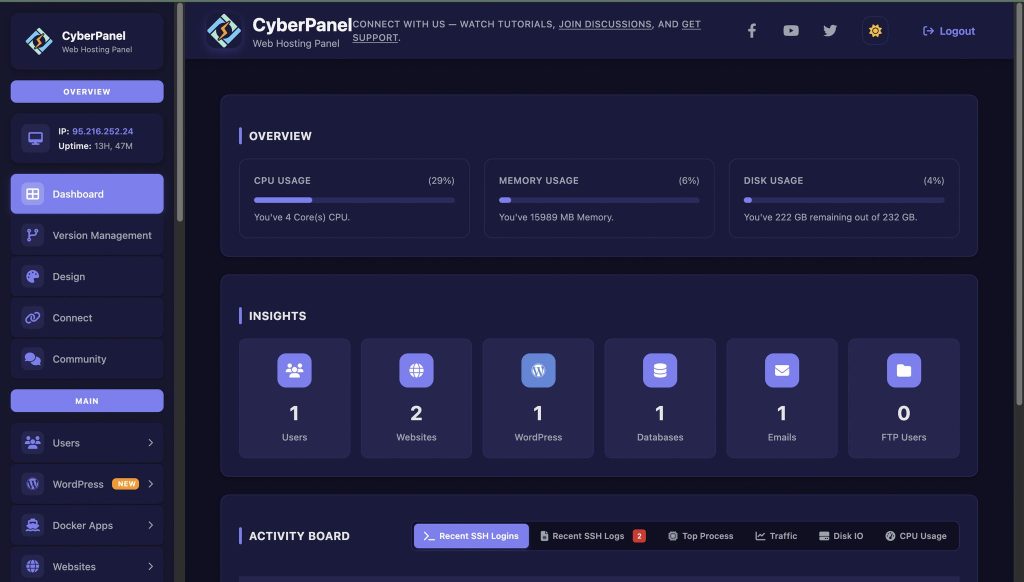We know that Kubernetes has transformed the way applications are deployed and scaled. However, it does not solve every networking challenge natively. Now, modern applications adopt microservices; managing communication, security, and observability between services becomes complex. That is where a service mesh Kubernetes comes into play.
A service mesh Kubernetes solution provides a dedicated infrastructure layer. This layer handles service-to-service communication, load balancing, observability, and security without changing application code. You can focus on writing features, while mesh manages traffic, authentication, retries, and monitoring.
In this guide, we will learn about service mesh, its importance, and how to implement it in Kubernetes environments in 2025.
Let’s learn together!
What is Service Mesh in Kubernetes?
A service mesh in Kubernetes is a dedicated layer that controls and secures communication between microservices. It uses sidecar proxies (like Envoy) injected into each pod to intercept and manage traffic.
Key Features of a Service Mesh:
- Traffic management: Load balancing, retries, failovers.
- Security: mTLS, zero-trust policies, access control.
- Observability: Tracing, metrics, logging.
- Policy enforcement: Rate limiting, quotas, firewall-like rules.
In short, a service mesh acts as the traffic controller, security guard, and observability agent for Kubernetes microservices.
Get exclusive access to all things tech-savvy, and be the first to receive
the latest updates directly in your inbox.
Why Do You Need a Kubernetes Service Mesh?
If you don’t have a Kubernetes service mesh, you can face complex network policies to secure traffic. Also, you can have a lack of visibility into service-to-service communication. Moreover, you can face manual implementation of retries, encryption, and logging.
By using a mesh, you will have:
- Consistency across microservices.
- Faster troubleshooting with metrics and tracing.
- Enhanced security with mTLS and zero-trust.
What Are the Best Service Mesh Options for Kubernetes?
There are multiple options, but the best service mesh for Kubernetes depends on your needs.
| Service Mesh | Best For | Key Features |
|---|---|---|
| Istio | Enterprise-scale, zero-trust | Traffic control, mTLS, observability |
| Linkerd | Lightweight, fast adoption | Simplicity, security-first |
| Consul | Multi-cloud, hybrid | Service discovery + mesh features |
| Kuma | Multi-cluster, modern | Built on Envoy, easy multi-mesh support |
How to Deploy Service Mesh Kubernetes?
We are going to use Istio to learn deploying service mesh in Kubernetes:
Step 1: Installing the Istio CLI
curl -L https://istio.io/downloadIstio | sh -
cd istio-*
export PATH=$PWD/bin:$PATH
Step 2: Installing Istio on Kubernetes
istioctl install --set profile=demo -y
Step 3: Labelling the Namespace
kubectl label namespace default istio-injection=enabled
Step 4: Deploying a Sample App
kubectl apply -f samples/bookinfo/platform/kube/bookinfo.yaml
Step 5: Verifying Services
kubectl get pods -n default
kubectl get svc -n default
What is the Difference Between Kubernetes Networking and Service Mesh?
Kubernetes offers basic networking out of the box. On the other hand, a service mesh extends these capabilities to provide advanced security, observability, and traffic management.
| Feature | Kubernetes Native | Service Mesh |
|---|---|---|
| Service Discovery | DNS-based (CoreDNS) | Advanced routing, traffic shifting |
| Security | NetworkPolicies only | mTLS, Zero-Trust, policy enforcement |
| Observability | Limited metrics (Prometheus) | Full tracing, logging, dashboards |
| Traffic Control | LoadBalancer/Ingress | Intelligent routing, retries, failovers |
In short, Kubernetes networking connects pods, while service mesh adds intelligence, resilience, and deep security.

Troubleshooting Common Issues in Service Mesh Kubernetes
Now, let’s discuss the most common issues and their solutions:
1. mTLS Handshake Failed
- Cause: Services may not have sidecar proxies injected, or certificates may be mismatched.
- Solution: Ensure all pods have sidecars running (e.g., Envoy for Istio, Linkerd proxy). Re-issue certificates if expired.
2. High Latency in Requests
- Cause: Overloaded Envoy/sidecar proxies, inefficient routing, or insufficient resources.
- Solution: Optimize resource requests/limits for sidecars. Use traffic splitting and retries smartly. Offload heavy workloads to lighter meshes like Linkerd.
3. Pods Not Communicating Across Namespaces
- Cause: Incorrect or missing namespace labelling for the mesh control plane.
- Solution: Verify that namespaces are labelled correctly (e.g.,
istio-injection=enabled). Check network policies for restrictions.
4. Resource Overhead in Large Clusters
- Cause: Heavy meshes (like Istio) consume significant CPU and memory.
- Solution: For smaller workloads, choose lightweight meshes like Linkerd. Tune sidecar injection policies to avoid unnecessary proxies.
5. Misconfigured Traffic Policies
- Cause: Wrong routing rules, missing destination rules, or conflict with ingress gateways.
- Solution: Validate virtual services and destination rules. Use mesh observability tools to trace routing flow.
Role of CyberPanel with Kubernetes Service Mesh

CyberPanel is a next-gen web hosting control panel powered by OpenLiteSpeed. By connecting Docker and Kubernetes workloads to CyberPanel, you can:
- Manage containerized apps through a graphical UI.
- Integrate service mesh configurations for secure deployments.
- Deploy microservices in hybrid hosting and Kubernetes setups.
This makes CyberPanel an ideal management layer for developers running Kubernetes clusters with a service mesh.
People Also Ask
Do I always need a service mesh for Kubernetes?

Not always. A service mesh is most useful for microservices-based applications with high communication needs, strict security requirements, or advanced observability needs. For small or monolithic workloads, Kubernetes’ built-in networking may be enough.
Q2. Which service mesh is best for production use in 2025?
It depends on your workload. Istio is feature-rich for enterprise-scale apps. Linkerd is lightweight and great for smaller clusters. Consul integrates well with multi-cloud and hybrid setups. The choice depends on your scale, complexity, and team expertise.
Q3. How does a service mesh impact DevOps pipelines?
A service mesh automates many DevOps tasks such as traffic routing, canary deployments, and blue-green rollouts. It reduces manual configuration and ensures faster CI/CD workflows with built-in reliability and observability.
Wrapping Up!
To sum up, a Kubernetes service mesh is your necessity in 2025. Service mesh in Kubernetes adds the missing layers of security, observability, and traffic control that native networking cannot handle alone. Tools like Istio or Linkerd give you mTLS, intelligent routing, and full visibility into microservices.
When paired with CyberPanel, you can manage containerized apps more easily while integrating service mesh for secure, scalable deployments.
If you’re running microservices, now is the time to adopt a service mesh and streamline management with CyberPanel—future-proof your Kubernetes infrastructure today!



